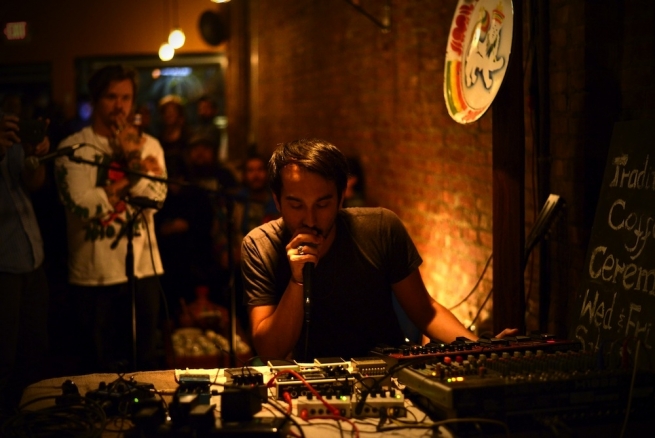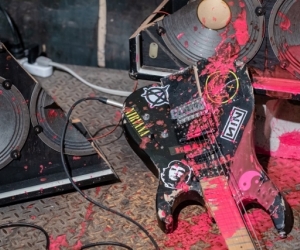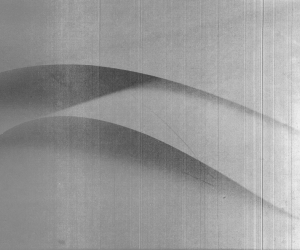
On a Sunday afternoon this past June I visited Outlet Fine Art, one of many independent galleries and performance spaces that have popped up in and around the Brooklyn neighbourhood of Bushwick in recent years. I was there to attend a performance by sound artist Roarke Menzies, the second in his series of appearances in the context of a group exhibition at the gallery. It was essentially a visual-arts show, and Menzies’ performance setup—a rather elaborate matrix of analog foot pedals, microphones, mixers, samplers, and loopers—remained in the gallery throughout the five-week run of the exhibit, as a work of art in itself, to be activated in performance each Sunday by the artist.
Originally from Vancouver, Menzies is one of a substantial number of resident sound artists who have helped make the postindustrial frontiers of Brooklyn and Queens a hotbed of noise, drones, and post-rock soundscapes. A variety of other venues in Bushwick, and in the adjoining neighbourhood of Ridgewood in Queens, regularly offer nights of experimental music and sound, as well as playing host to related festivals such as Ende Thymes. Menzies found his way to Bushwick by way of Los Angeles and Portland, Oregon, and he brings a west-coast sensibility to his carefully sculpted electroacoustic works. But the thriving outer-borough scene where he has lived for ten years has definitely left its mark on his work.
Almost as soon as he arrived in 2006, Menzies began what would become a long series of interdisciplinary collaborations that introduced his work to the world of art fairs, dance spaces, and performance art venues, yet also limited the scope of his creativity. Recently, however, he has been focusing on his own autonomous sound pieces. Within the past year, Menzies released his first two albums on both cassette and digital through his Coup de Glotte label. Shapes appeared in October 2015, Corporeal in April 2016; together, they comprise a consistently compelling collection of dark, ambient-industrial textures. Inspired by the soundworlds of artists such as William Basinski, Tim Hecker, and Oneohtrix Point Never, Menzies has developed his own take on this rich sonic stream, emphasizing his own voice as the primary signal for processing. Long vocal tones and beatbox-like vocalizations are the predominant sounds, all of which he loops, processes, and mixes with a range of other sonic and percussive material.
Sensitivity to the raw physicality of sound also distinguishes Menzies’ work, something made vividly manifest at his Outlet performance. After attaching several sound exciters (a type of surface transducer) to parts of the gallery’s structure, he routed parts of his multichannel live performance mix to them. In performance, Menzies generates numerous independent loops that are then routed independently to any number of outputs. In this instance, certain loops were routed to the windows, air ducts, etc., via standard speaker cables connected to the transducer—in effect, turning objects into speakers, with the windows, air ducts, and walls shaking, rattling and otherwise resonating in the space. All this blended with the rest of his live amplified mix for an immersive and powerful experience. In this moment, Menzies became the focal point of the exhibition, bridging the visual, spatial, and sonic dimensions that made up the gallery experience.
I met Menzies one afternoon earlier this spring at a neighbourhood bar on Flatbush Avenue in Brooklyn’s Prospect Heights, a few blocks from where he works part-time for an artist management agency, to learn more about how he came to be a sound artist and performer. He described his background in theatre, a world his parents both inhabit, his almost-career as an actor, a youth spent in Vancouver and Portland, teen years in Los Angeles, and his current life in Williamsburg, where he shares an apartment with his girlfriend, a visual artist. Though he spent many years singing in youth choirs, and occasionally played in bands during high school, music remained largely a latent interest. After high school, however, Menzies enrolled in audio and music classes at Santa Monica College, his first significant move towards a career in sound. His studies took a step forward when he enrolled at the Sonic Arts Center at City College of New York, in a program that combines audio technology with basic musicianship and theory. The two years he spent in the program broadened his skill set and deepened his interest in the field of sound studies.
Around this time, in 2007, a serendipitous conversation with one of his then roommates led to Menzies contributing the musical score to a dance work that was performed at the Bushwick Starr. That was followed in quick succession by several other collaborations that provided the impetus to further develop his own sonic language. One such collaboration was a large-scale performance work, Two Alike, developed with choreographer Jack Ferver and visual artist Marc Swanson, presented at Houston’s DiverseWorks Theater, The Kitchen in New York, and the Institute of Contemporary Art in Boston. He later collaborated on an ambitious series of radio plays and podcasts with the writer Paul Rome, including, most recently, Philadelphia And Other Stories, a radio-inspired stage work pairing new works of literary fiction with original music and sound, presented at the 2015 Composers Now festival in New York City. This intense period of activity continued apace for several years and took him on tours throughout the U.S. and Mexico, while garnering media attention from such outlets as the New Yorker, Hyperallergic, and numerous culture blogs.
While Menzies has clearly found a secure niche providing sound scores to the dance, theatre, and performance art communities—a function that can easily subsume a composer or sound artist’s unique voice and ambition—it remains to be seen how far he can take his solo act. The recent recordings make a compelling case for his indeed finding a receptive audience. Throughout the six tracks that make up Shapes, Menzies presents a consistently subdued and deeply resonant sonic space, a collection of poetic longings that stands up well alongside the output of artists who have inspired him. While noisier textures sometimes predominate, the stronger moments are those that allow fragments of melody and pitch to take centre stage, such as in “Forget My Fate,” the album’s fourth track, which features an almost hummable tune in counterpoint with a subtle, machine-driven rhythm. Elsewhere there are various treatments of classic drone structures, one of which pays direct homage to drone pioneer La Monte Young. Overall, Shapes is a strong debut that rewards repeated listening.
With Corporeal, Menzies experiments with a wider range of approaches, with mixed results. Where Shapes has a romantic undercurrent to it, Corporeal often sounds more like an earwitness report from the East Williamsburg warehouse district. Sounds of repetitive industrial machinery predominate, often mixed with what sound like urban field-recordings, giving the album more the quality of a sound-design project than is heard on its predecessor. There is also a greater focus on psychoacoustics here, such as in “Flicker Film,” an almost-twelve-minute study in what might be described as strobe audio. As the track’s title suggests, the dominant motif is a flickering effect, sonically evoking Tony Conrad’s classic experimental film The Flicker. Menzies’ more musical side returns briefly on track six, “The Wake,” a piece that might have easily fit on Shapes. Interestingly, listening to the cassette version of this album, with its built-in intermission at the end of side A, was somewhat of a revelation. Not only did I find the analog sound richer and more visceral, I also perceived the album as having two distinct parts, and thus a richer meaning.
With these two recent releases behind him, Menzies has significantly stepped up his solo performing schedule. In addition to numerous recent and upcoming appearances in New York City, he visited Los Angeles this summer, appearing alongside Sarah Davachi and Mem1, and is working on plans for wider touring through the U.S. and Canada. With this surge of activity, Menzies appears to be an artist fully coming into his own. For travellers through the experimental electronic underground, Roarke Menzies is a name to watch.
Top photo of Roarke Menzies performing at the release of his album Shapes at Bunna Cafe in Brooklyn, NY, (October 10, 2015) courtesy of: Precede / Proceed


